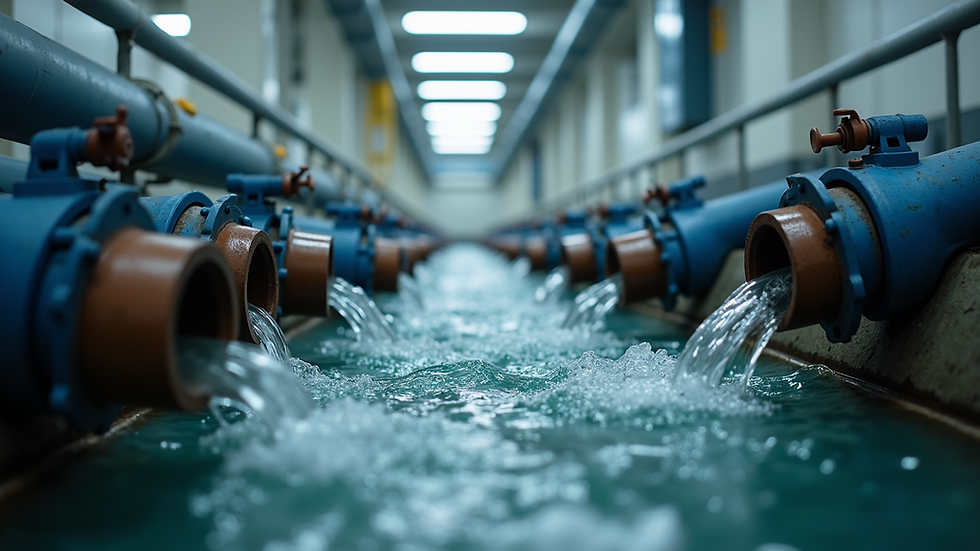Understanding Industrial Wastewater Sources and Solutions
- karan9377
- Oct 14
- 4 min read
Industrial processes generate significant volumes of wastewater that require careful management to protect the environment and public health. This wastewater contains various pollutants depending on the industry, making its treatment complex and essential. Understanding the sources of industrial wastewater and the available wastewater treatment methods is crucial for industries aiming to comply with regulations and minimize their environmental footprint.
Common Sources of Industrial Wastewater
Industrial wastewater originates from diverse manufacturing and processing activities. Each industry produces wastewater with unique characteristics based on the raw materials used and the processes involved. Some common sources include:
Chemical Manufacturing: Produces wastewater containing hazardous chemicals, heavy metals, and organic compounds.
Textile Industry: Generates wastewater rich in dyes, salts, and suspended solids.
Food and Beverage Processing: Releases organic matter, oils, and grease into wastewater.
Metal Finishing and Electroplating: Contains heavy metals and toxic substances.
Pulp and Paper Mills: Produces wastewater with high biochemical oxygen demand (BOD) and suspended solids.
These sources contribute to the complexity of wastewater treatment, requiring tailored solutions to address specific contaminants effectively.

Overview of Wastewater Treatment Methods
Wastewater treatment methods vary depending on the type and concentration of pollutants present. The goal is to reduce contaminants to acceptable levels before discharge or reuse. The main categories of treatment methods include:
Physical Treatment: Involves processes like screening, sedimentation, and filtration to remove solids and suspended particles.
Chemical Treatment: Uses chemical agents to neutralize harmful substances, precipitate metals, or disinfect the water.
Biological Treatment: Employs microorganisms to degrade organic pollutants through aerobic or anaerobic processes.
Each method plays a vital role in a comprehensive treatment system. Often, industries combine these methods to achieve optimal results.
Physical Treatment Techniques
Physical treatment is usually the first step in wastewater management. It removes large solids and reduces the load on subsequent treatment stages. Common techniques include:
Screening: Removes large debris such as plastics and rags.
Sedimentation: Allows suspended solids to settle by gravity.
Filtration: Uses sand or membrane filters to capture finer particles.
These processes are essential for protecting equipment and improving the efficiency of chemical and biological treatments.
Chemical Treatment Techniques
Chemical treatment targets dissolved pollutants and pathogens. Key processes include:
Coagulation and Flocculation: Chemicals like alum or ferric chloride cause particles to clump together for easier removal.
Neutralization: Adjusts pH levels to safe ranges.
Oxidation: Breaks down organic contaminants using oxidizing agents such as chlorine or ozone.
Disinfection: Eliminates harmful microorganisms before discharge.
Chemical treatment is particularly important for industries dealing with toxic or hazardous substances.

What are the three types of industrial wastewater treatment?
Industrial wastewater treatment can be broadly classified into three types based on the treatment approach and objectives:
Primary Treatment: Focuses on removing large solids and suspended particles through physical processes like screening and sedimentation. This step reduces the pollutant load but does not address dissolved contaminants.
Secondary Treatment: Employs biological processes to degrade organic matter. Aerobic treatment uses oxygen-loving bacteria, while anaerobic treatment relies on bacteria that thrive without oxygen. This stage significantly lowers biochemical oxygen demand (BOD) and organic pollutants.
Tertiary Treatment: Provides advanced purification to remove remaining contaminants such as nutrients, heavy metals, and pathogens. Techniques include chemical precipitation, filtration, and disinfection. Tertiary treatment ensures the treated water meets stringent discharge or reuse standards.
Combining these treatment types allows industries to manage wastewater effectively and comply with environmental regulations.
Challenges in Industrial Wastewater Management
Managing industrial wastewater presents several challenges that require strategic planning and investment:
Complex Pollutant Mixtures: Industrial effluents often contain a mix of organic, inorganic, and toxic substances that complicate treatment.
High Variability: Wastewater composition can vary daily or seasonally, demanding flexible treatment systems.
Regulatory Compliance: Industries must meet strict discharge standards to avoid penalties and environmental harm.
Cost Considerations: Advanced treatment technologies can be expensive to install and operate.
Sludge Disposal: Treatment generates sludge that requires safe handling and disposal.
Addressing these challenges involves adopting innovative technologies, continuous monitoring, and optimizing treatment processes.

Practical Recommendations for Effective Wastewater Treatment
Industries can enhance their wastewater management by implementing the following best practices:
Conduct Comprehensive Wastewater Characterization: Regularly analyze wastewater to understand pollutant types and concentrations.
Implement Source Reduction: Modify processes to minimize wastewater generation and pollutant load.
Adopt Integrated Treatment Systems: Combine physical, chemical, and biological methods tailored to specific wastewater profiles.
Invest in Monitoring and Automation: Use sensors and control systems to optimize treatment efficiency and detect issues early.
Train Personnel: Ensure staff are knowledgeable about treatment processes and safety protocols.
Explore Water Reuse Opportunities: Treat wastewater to standards suitable for reuse in industrial processes, reducing freshwater consumption.
By following these recommendations, industries can achieve sustainable wastewater management and reduce environmental impact.
Moving Forward with Sustainable Wastewater Solutions
Effective management of industrial wastewater is essential for environmental protection and regulatory compliance. Understanding the sources and characteristics of wastewater helps in selecting appropriate treatment methods. Combining physical, chemical, and biological treatments ensures comprehensive pollutant removal.
Industries are encouraged to explore innovative technologies and adopt best practices to optimize wastewater treatment. Sustainable solutions not only protect natural resources but also enhance operational efficiency and corporate responsibility.
For more detailed information on advanced wastewater treatment technologies and solutions, visit industrial wastewater.
This comprehensive overview provides a solid foundation for industries seeking to improve their wastewater management strategies. Implementing effective treatment methods safeguards the environment and supports sustainable industrial growth.



Comments